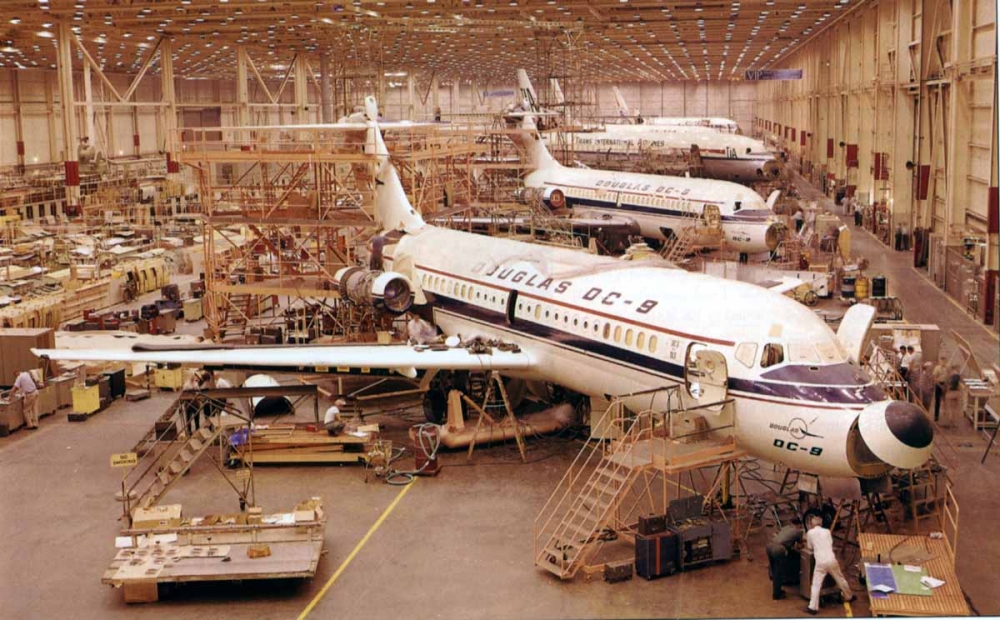How do you measure the impact of an airplane? By how many people it brought together, by the routes it pioneered, perhaps by the sheer number built?
By any of those standards the original Douglas DC-9 was a winner. Now comes word the Delta Air Lines, the carrier that launched the distinguished line of airplanes back on December 8, 1965 is operating its last DC-9 flight on January 6.
Flight 2014 (that’s the way Delta designated it) is scheduled to push back from the gate at Minneapolis/St. Paul International at 4:20 p.m. Central Time in the U.S. and head southeast to Atlanta.
Over the years Delta’s operated a total of 305 DC-9s. In all, according to Bill Yenne’s book The Story of the Boeing Company (into which Douglas successor McDonnell Douglas merged), 976 of the classic rear-engine twinjets were built over the years. The idea behind the DC-9 was to bring pure-jet service to smaller cities, on shorter routes. The original 90-passenger DC-9-10 had a range of just 1,565 miles. By comparison its larger stable mate at the time the DC-8 had a range of up to 6000 miles.
Delta used its first DC-9s on such southern-U.S. city-hopping routes as Dallas-Shreveport-Jackson-Birmingham-Atlanta. This sort of scenario prevailed in an era prior to airline deregulation. Now, most routes are operated on a “hub-and-spoke” basis, with nonstops radiating from hubs such as Atlanta
This AirlineRatings.com editor was one of millions of flyers whose life was touched by the airplane. On a cold March day in 1969 I boarded a Continental Airlines DC-9 for the 564-mi/907km flight from Dallas Love Field to El Paso. I was on my way to train for war, a trip that a few months later would be continued aboard a Flying Tigers DC-8-63 bound for Cam Ranh Bay in a country they once called South Vietnam.
While the original DC-9 has all but exited the arena, the airplane’s descendents remain viable players. The later DC-9 series developments were renamed the MD-80 in the 1980s, and McDonnell Douglas modified the airplane further with the MD-90 and finally MD-95. The latter was renamed the Boeing 717 after the merger with Boeing in 1997.
The MD-80 series is a workhorse for U.S. leisure carrier Allegiant, as well as American Airlines while Delta has just acquired a fleet of 88 Boeing 717s. Delta is getting the 717s as US carrier Southwest Airlines sheds its non-737 fleet. Southwest inherited the airplanes when it purchased AirTran.
The DC-9 is the last design built by the famous Douglas Aircraft Company before its merger with McDonnell Aircraft Company in 1967. Many old timers say it was the last airplane built which had Donald Douglas Snr’s stamp of quality and integrity.
The reliability of the DC-9 became legendary in its day and it can be truly said that it was the first DC-3 replacement of the jet age. That mantle is now held by the Boeing 737 and Airbus A320, which were competitors of the DC-9/MD-80 series.
And in another twist it was McDonnell Douglas’s reluctance to build an all new successor to the DC-9/MD-80 series that helped doom the once great airplane builder.
In the early 1980s Delta wanted to launch the 180-seat DC-11 which was to be a twin aisle six across airplane. McDonnell Douglas however didn’t want to commit because of the financial risk.
Then in 1988 a planned merger with Airbus collapsed because of a disagreement over a new single-aisle airplane. Airbus rightly wanted any new plane to be based on the A320, which was all new technology but then Chairman of McDonnell Douglas, John McDonnell insisted that it should be based on the MD-80 series.
After the merger of Douglas with McDonnell in 1967 the company only built one new commercial airplane – the DC-10. Every “new” model after that was a derivative.
What we all inherit with the disappearance of the last of the classic DC-9’s are suitcases full of memories, remembrances of the days when jet travel was shiny and new, and the skies a clear cerulean blue.
-With Geoffrey Thomas
























